| Biographies & Memoirs |
| In Pictures: |
****Hyperlinked titles will take you to our copy on sale or prebuilt searches of copies on sale****
Useful Links:
Books on Ebay-see our specially prebuilt search below
Titles to Look Out For:
[In alphabetical order of title; date indicates original edition - later editions are included in entry]
1970. Christiaan Barnard. ONE LIFE
1974. Georges Clemenceau. A Political Biography
1993. In Focus, Out of Step by Antony Twort
1986. J'Accuse by Claude Robinson
1980. The Kemble Era: John Philip Kemble, Sarah Siddons and the London Stage by Linda Kelly
1990. The Kindness of Strangers by Bernard Braden
1955. Leopards In The Night
1948 (and later ed.s) Ndotolu: The Life Stories of Walter and Anna Fisher of Central Africa
1986. Oliver Messel: A Biography by Charles Castle>
1987. Oro by Cizia Zyke (translated by Stanley Hochman)
1993. Signals to the Right; Armoured Corps to the Left by Ron Larby
1965. Walker, R.N. by Terence Robertson
1952. The White Rabbit: The Story of Wing Commander F. F. E Yeo-Thomas by Bruce Marshall |
On Amazon: |
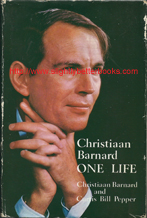
1970, George G. Harrap & Co., hbk
In stock, click image above to buy for £14.75 (good condition), not including post and packing, which is Amazon UK's standard charge (£2.80 for UK buyers)
Alternative online retailers to try:
Click here to access our prebuilt search for this title on Abebooks
Click here to access our prebuilt search for this title on Alibris
Click here to access our prebuilt search for this title on Ebay to access our prebuilt search for this title on Ebay
Click here to access our prebuilt search for this title on Biblio
|
About this book: Few men have achieved world fame more quickly than Christiaan Barnard, or faced more criticism and misunderstanding as a result. Not only did he stir up antagonism and jealousy in the medical world, but he set churchmen, racialists, politicians, and philosophers arguing with the same vehemence as the man in the local pub. Yet, in spite of banner headlines in the world press and international television appearances, surprisingly little is known about the man himself; his background, early medical career, training in America, his marriage, his amazing capacity for work and for setting himself impossible goals and then achieving them. One Life explains how this relatively unknown professor in a South African hospital was able to conduct the most daring and complicated operation yet attempted by man - the first human-to-human heart transplant. The story starts with Chris as a barefoot boy in an up-country town in South Africa, where his father was Pastor of the Dutch Reformed Church, which had a coloured congregation. His mother was equally god-fearing, but also exceptionally ambitious for her children; from their schooldays onwards, it was made clear that Chris and his brothers should be successful in everything they attempted.
After doing well at school, Chris decided that he wanted to be a doctor, and, wearing his brother's cast-off clothes, he was sent to Cape Town University. Here he spent six years of backbreaking study in wards, labs and morgues "all alone, with a hunger inside to get to the top". Married, and in private practice, he foresaw the immense possibilities offered by "constructive" heart surgery. As a result of this he seized the golden opportunity of going to America to work under one of the greatest teachers in experimental surgery. The true stature of Christiaan Barnard was apparent when he decided to cram the six years' work normally required to obtain a Ph.D. into a two-year crash course. One result of this fantastic work schedule was to antagonize his wife, who left with the children for South Africa. Even his own delayed return with a Ph.D., a Master of Science degree, a heart-lung machine, and a grant on which to run it, was greeted with the words: "you never wrote except to say you were not coming home".
Back in Africa, Barnard began assembling his heart transplant team and perfecting their techniques. Finally, the team was ready to go. All they needed was a donor and a recipient. The long and detailed description of the first ever human-to-human heart transplant - the problems, the dangers, the doubts, and the agony of the eighteen days that Louis Washansky survived - forms the final section of the book. Its crescendo of drama makes one of the most powerful and sustained pieces of writing of its kind. The book closes with Barnard about to conduct his second transplant on Philip Blaiberg.
One Life is, of course, a success story, but it is like no success story you have ever read, for Barnard's ambition is not concerned with wealth, material comforts or power. The difficulties, opposition and self-doubts so frankly described in this biography were overcome not only by his natural toughness but by his dedication to his work, and his deeply religious conviction that it is his destiny to save human life and relieve suffering |
|
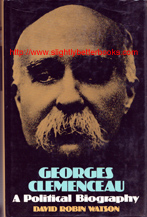
1974, Eyre Methuen, hbk
In stock, click to buy for £150, not including post and packing, which is Amazon UK's standard charge (£2.80 for UK buyers; more for overseas customers)
Alternative online retailers to try:
Click here for our prebuilt search for this book on Abebooks
Click here for our prebuilt search for any edition of this title on Alibris
Click here to access our prebuilt search for this title on Ebay to access our prebuilt search for this title on Ebay
Click here to access our prebuilt search for this title on Biblio









|
- Georges Clemenceau. A Political Biography [top]
Written by David Robin Watson
First published in 1974 in Great Britain by Eyre Methuen in hardback, 463pp, ISBN 0413264106
Price when first published: £9.50 net. The photograph on the cover is of Clemenceau in his seventies
About this book/synopsis: Clemenceau is best known as the French premier who led his country in the last year of the first World War, and represented her at the peace negotiations of 1919. But this came at the end of a long life in which he was never far from the centre of the political stage. By 1862 - at the age of twenty-one - he was already a student revolutionary; he was closely involved in the outbreak of the Paris commune and throughout the next fifty years he was constantly a central figure in the major crises of the Third Republic - Boulangism, Panama, the Dreyfus Affair. This biography describes his career as journalist and editor, as well as politician, and throws new light on the history of the period. It also provides a picture of a fascinating personality. Clemenceau was a many-sided man whose interests ranged from horsemanship, hunting and duelling to medicine, science and the arts. He also wrote a novel, a play and philosophical works; the painter Claude Monet was a close friend. Surprisingly, Clemenceau has never been made [up to 1974 when this was published] the subject of a full-length scholarly biography, and this book seeks to fill the gap. It is provided with full references, and is based on deep research into previously unused unpublished material, as well as on Clemenceau's voluminous writings, and on the Parliamentary record. It has however, been written with the general reader in mind, so that even the reader with little previous knowledge of this period of French history will find the background filled in clearly and revealingly
Contents:
Acknowledgements
Part One. Childhood, Youth and the Commune, 1841-1871
1. Childhood and Youth
i. Ancestry and Childhood
ii. Medical Student
iii. Visits to the United States
2. The Commune
i. The Siege of Paris
ii. The Outbreak of the Commune
iii. The Ligue d'Union Républicaine
Part Two. The Radical Attack, 1871-1889
3. Challenger from the Left
i. Introduction
ii. The Establishment of the Third Republic, 1871-1879
iii. Challenger from the Left
iv. First Round: Tunis and Egypt, 1881-1882
4. Clemenceau versus Ferry
i. Clemenceua versus Ferry, 1883-1885
ii. The 1885 elections
5. Boulangism
i. Clemenceau hopes for office, 1885-1887
ii. Boulangism, 1888-1889
Part Three. Defeat and Resurgence, 1889-1906
6. Panama
i. 'The Revolution is a bloc', 1889-1892
ii.
The Panama Scandal, 1892-1893
iii. Assessment of Clemenceau's career down to 1893
7. The Dreyfus Affair
i. A New Start, 1893-1898
ii. The Dreyfus Affair, 1898-1902
iii. Senator, 1902-1906
Part Four. The First Ministry, 1906-1909
8. Minister of the Interior
i. The breakdown of the Bloc des Gauches
ii. Minister of the Interior
iii. The elections and the New Chamber
9. Clemenceau as Premier
i. The Clemenceau Cabinet
ii. The Revolt of the Winegrowers
10. Clemenceau as Strike-Breaker
i. The Draveil Strike
ii. Parliamentary Crises, March-July 1909
11. Foreign Policy
i. The Algeciras Conference, 1906
ii. France, Russia, Germany and Britain
iii. The Franco-German agreement on Morocco
Part Five. Opposition, 1909-1917
12. In Opposition before the War
i. Lectures on Democracy
ii. Agadir and the fall of Caillaux
iii. Electoral Reform and the 'three year law'
13. Opposition in Wartime
i. Opposition in Wartime: against Viviani and Briand, 1914-1917
ii. The mutinies and the attack on Malvy, April-August 1917
iii. Against a compromise peace, September-November 1917
Part Six. Pere-La-Victoire, 1917-1918
14. Second Ministry: Domestic Politics
i. Pere-La-Victoire
ii. Domestic Politics
15. Military Strategy
i. Foch becomes Supreme Allied Commander
ii. Conduct of the War, April-July 1918
16. Russian Intervention and Victory
i. Intervention in Russia, 1918
ii. Victory, August-November 1918
Part Seven. The Peace Settlement and After, 1918-1929
17. The Versailles Treaty
i. The Armistice
ii. Peace Preliminaries
iii. The Crucial Bargains
iv. Defence of the Treaty
18. The Middle East and Russia
i. The Middle East
ii. Russian Intervention, 1919
19. Domestic Politics and Last Years
i. Domestic Politics
ii. Last Years
Part Eight. The Conclusion
Appendices
i. Membership of the Clemenceau Cabinets
ii. The Constitution of the Third Republic
iii. Electoral Systems
iv. The Political Parties
v. Governments and Elections, 1870-1920
vi. Biographical List
vii. Chronological Table
Sources and Bibliography
Index |
|
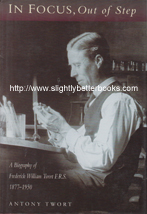
1993, Alan Sutton, hbk
In stock, click image above to buy:
1 good condition, £12
1 very good, £14.99
Alternative online retailers to try:
Click here to access our prebuilt search for this title on Abebooks
Or click here to access our prebuilt search for this title on Alibris
Or click here  to access our prebuilt search for this title on Ebay to access our prebuilt search for this title on Ebay
Click here to access our prebuilt search for this title on Biblio












|
- In Focus, Out of Step: A Biography of Frederick William Twort F. R. S. 1877-1950 [top]
Written by Antony Twort
Published in 1993 in Great Britain by Alan Sutton in hardback with dustjacket, 340pp, ISBN 0750903279
Cover Illustrations: Front: F. W. Twort at his laboratory bench in the Brown Institution, 1919. (Photograph taken by his assistant and future wife, Dorothy Nony Banister)
Back: The Zeiss Microscope used by F. W. Twort in the 1930s
British Library Cataloguing in Publication Data:
Twort, Antony
I. Title
574.8092
ISBN 0-7509-0327-9
Library of Congress Cataloguing in Publication Data
Twort, Antony, 1923-
In focus, out of step : a biography of Frederick William Twort F.R.S., p. cm.
Includes bibliographic references (p. ) and index
ISBN 0-7509-0327-9:$45.00
1. Twort, Frederick William, 1877-1950. 2. Bacteriologists-Great Britain-Biography. 3. Virologists-Great Britain-Biography
I. Title
QR31.T86T86 1993
589.9'0092-dc20
[B]
About this book/synopsis: Frederick William Twort F.R.S. (1877-1950) was an important bacteriologist in the days when that branch of science, if not in its infancy, was regarded within the medical world as something of a 'poor relation'. He was Superintendent of the unique Brown Animal Sanatory Institution in London for 35 years, where he made several far-reaching discoveries, most notably that of the bacteriophage in 1915. Although in 1929 he was elected a Fellow of the Royal Society, Twort never felt that his work received proper recognition in more practical financial terms. His professional life was dogged by the struggle for research funds, yet he was a firm individualist and never one to opt for a compromise. this rigid and sometimes misplaced adherence to what he believed to be the only path for a true scientist almost inevitably brought him into conflict with those of a more pragmatic disposition. This is an unusual biography of a most interesting and unconventional character. His upbringing was harsh, influencing his later attitude to those in positions of authority, and his professional life one of turmoil and controversy. But behind a somewhat remote exterior was a warm and loving individual who had firm friends, pursued many hobbies and enjoyed a happy home life with his wife and four children
Contents:
Preface; Author's Note and Acknowledgements
Chapters:
1. Early Years: Trouble at Home
2. Escape to St. Thomas's Hospital
3. The London Hospital: First Researches
4. Independence Gained: The Brown Institution
5. The Johne Bacillus and Bacterial Growth Factors
6. No Support but a Momentous Discovery
7. Salonika and Conflict with the Army
8. Feverish Writing
9. A Lady to the Rescue: Back to the Army: Marriage
10. The Army Fights Back: A Skirmish with the MRC
11. Family Life and a Wireless Invention
12. FRS: New Research: Professorship
13. Bacteriophage: Dispute over Priority
14. A Petition of Right Lodged Against the Crown
15. A Little Satisfaction
16. A Lost Legal Action
17. A New Scientific Venture
18. Wartime Existence at Home
19. Rubber Crisis: Another Disappointment
20. A Major Salvage Operation: Blighted Hope
21. Turmoil
22. Anguish
Epilogue
Appendix 1: Bibliography
Appendix 2: The Brown Animal Sanatory Institution
Appendix 3: 'An Investigation on the Nature of Ultra-Microscopic Viruses' by F. W. Twort
Index
Illustrations (all black and white photographs unless otherwise specified):
-'Hurstwood', London Road, Camberley. The new family home as it appeared c.1880. Shows Dr. William Twort with his 'Facile' bicycle in the front garden
-Freddy (F. W. T.) as a young child with battledore and shuttlecock
-The village sweep and midwife, Bagshot, 1890s
-Dr William Twort and his wife Elizabeth with their first eight children; the photographic proceedings being observed by curious domestic staff
-All eleven children at Hurstwood: Sissy (Adelaide Elizabeth) b.1876; Freddy (Frederick William) b.1877; Lionel (James Lionel) 1879;
Ferd (John Ferdinand) 1880; Charlie (Charles Claud) 1882; Reggie (Reginald Frank) 1883; Maude (Sarah Maude) 1884; Monty (Joseph Montague) 1886; Dolly (Violet Gertrude); Florrie (Amy Florence) 1889; Hilda (Lilian Hilda) 1891
-Dr. W. H. T., with Freddy, Lionel and Ferd about to set off on a trial run
with the boys' newly-purchased 'penny-farthing' bicycles, c.1890. Freddy's father has an improved 'Geared Facile' whereas Freddy and Lionel have 'Ordinaries' and young Ferd has a simple 'Facile'.)
-Freddy with his cornet
-A young Freddy Twort in solitary contemplation of the immense Royal Military College opposite his home
-At St. Thomas's Hospital, c.1900. F. W. T. seated front centre
-The Eleven Tworts, c. 1906
-The Twort-Cleminson team in a relay race. F. W. T. receives the baton, c.1903
-F. W. T. is first past the post in the race
-Carrying off the prize
-F. W. T. in the bacteriology laboratory, London Hospital, Whitechapel, 1906
-William Bulloch his Chief, later FRS (Courtesy of London Hospital Archives)
-Bacteriology group, London Hospital, c.1907. Note that 'W. B.' has elected the extreme left of the back row, whilst placing his cleaning ladies and laboratory assistants in front. F. W. T. is holding the chimpanzee, 'Lord Whitechapel'
-The Twort ladies quintet, c.1908
-'Hart Dene', Bagshot, c.1910
-H. O. Poulter at his grand piano, Hart Dene, c.1910
-H. O. (on the left) at the range. Location is unknown, but may be the Olympic games at Stockholm in 1912. Otherwise, it may be Bisley
-Black and white map of S. E. Central London, 1925, showing the location of the Brown Institution (arrow), St. Thomas's Hospital, Houses of Parliament, Waterloo and Vauxhall railway stations and the Oval cricket ground
-Black and white artist's impression (J. W. Thompson) of the Brown Institution when first hurriedly established in 1871. Within a few years, the semi-detached house had been replaced by a laboratory, and a row of houses as an investment. See plan p.327
-The entrance from Wandsworth Road following redevelopment of the site some years later (photograph was taken after extensive bomb damage
-Portrait photograph of G. L. Y. Ingram, MRCVS (1884-1914), Veterinary Surgeon to the Brown Institution
-Black and white illustration from the early days of the Brown Institution, taken from 'The Graphic', April 1875
-The pickled apple and pear with 'The window that was gently tapped at 12:19am., on May 28th 1911' printed on both fruits
-The Dresden Hygiene Certificate, 1911
-The Troop Massila as she appeared some years prior to the 1914-18 War. Inset: The torpedoed and beached transport Norseman.
-Salonika from the air, January 1917
-Temporary Captain F. W. in the Base Laboratory, Salonika, 1916
-'Bacteria', from an original painting by Temporary Lieutenant James McBey, an official war artist in the Middle East, chiefly the Palestine campaign, 1917
-Sir Rickman Godlee Bt., KCVO, FRCS, MS (1849-1925)
-Dr Félix d'Hérelle, 1873-1949
-Dorothy Nony Banister, c.1914
-Billetee and subaltern friend (ex-UPS Battn.) Frederick John Rayner Simpson. Killed in action, France, 31.7.17, aged 29
-May Mellanby, later Lady Mellanby, teacher in Science as Applied to Housecraft, Battersea Polytechnic, c.1916
-Dorothy Nony Banister is seen seated in a laboratory in a lesson taught by May Mellanby
-'The Wilderness' at the time of purchase in 1917
-The new drive manually cut through the wooded rear garden by F. W. T. Opened February 1923
-A corner of the drawing-room, the scene of much wireless experimentation and even greater endeavour on the typewriter. Note the two bracket gas lamps
-F. W. T. at the Brown Institution looking into a microscopic, 1918
-D. N. B., his assistant and future wife, 1918
-Annie, the 'Brasso Queen'
-Engagement Happiness
-Annie Bannister
-Frederick J. Banister, architect, father-in-law elect
-Wedding day, May 3rd 1919
-The enthusiastic photographer on honeymoon, with his much-valued post-card Kodak camera
-Enjoying the special pleasure of a first-born, Betty, spring 1921
-Off to Scarborough for a medical conference, 1923
-All ready packed for a rare family holiday. Mother and two small children took the train
-In suit and tie at the seaside with Betty and Antony, 1924
-A rest from log-cutting to take a picture of the new baby, Pamela, 1924
-Nony with the first 'Brutus'
-Wireless construction on a sunny day outside the workshop, with a flourishing brazier to heat the soldering iron
-The ignominious departure of the dead Cubitt motor-car by arrangement with the local gipsies. The Wilderness children looking the part
-Dr. William Twort in Masonic regalia
-W. H. T. on horseback
-In the uniform of a Red Cross Volunteer c.1917
-Elizabeth in her much-loved garden
-Later in life, wearing one of her many self-made shawls
-The Wilderness children with 'Brutus 2nd' - Pamela, Betty, Gillian and Antony
-In the snow
-The square summerhouse designed and constructed by F. W. T.
-A picnic in the garden
-F. W. T. in a typical posture for some horticultural investigation or experiment
-The mysterious sandstone, at first thought to be a neolithic saddlequern. This met with a sceptical response from the British Museum
-The family on bikes a generation on. Father demonstrating his new lightweight bicycle on the tennis lawn against strong competition
-Newspaper clipping: 'The King Permits Professor to Sue for £600 A Year' - the money was to come from the Medical Research Council. From the Daily Express, March 25th, 1937
-Sir Walter Morley Fletcher, KBE, FRS, 1873-1933
-Sir Edward Mellanby, KCB, GBE, FRS, 1884-1955
-The essential core experimental apparatus designed and constructed by F. W. T. in the laboratory workshop for his later virus researches (photograph taken after 1944 bomb damage). It permitted controlled periodicity of light of varying wavelength, and of temperature, within the special incubator. Arrows: (a) the 'home made' D. C. electric motor, geared to (b) the revolving platform surrounded by a pair of semi-circular test-tube racks (only one shown). F. W. T. received considerable criticism for spending so many hours making such equipment
-Hubert Maitland Turnbull, FRS (1875-1955)
-An Exhibit from the great Brief taken into Court. Facsimile of home printing (reduced)
-Newspaper clipping: 'Professor Who Lost All Stars Afresh', taken from the Daily Herald, February 2nd 1938
-Disasters in Court do not stop important work in the garden. Some assistance with cross-cut saw from neighbour Major Donald Rule, Indian Army, retired
-Left: 'H.O', with right arm weakened as a result of a war wound, prefers to observe such vigorous activity from a safe distance
-Corporal Eric Guest, New Zealand Army, about to take a most welcome bath at The Wilderness, 1941
-Poster. Portion of Ministry of Supply notice, effective September 7th, 1942
-Salvage operations at the ruined Brown Institution, July 1944. Brand's Essence of Beef factory chimneys in the background
-The Professor in his bombed laboratory, July 1944
-Enforced retirement, but an ever active mind. F. W. T. in the garden in his armchair
-'We ought not to use razors [or Professors] to chop blocks' (Sir Walter Fletcher in a letter to F. W. Twort, December 14th 1932). F. W. T. in characteristic posture splitting logs for kindling wood, 1949, a year before his death.'
|
|
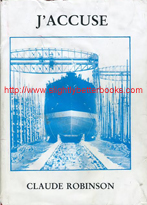
1986, People's Publications, hbk
Sorry, sold out, but click image above to access a prebuilt search for this title on Amazon UK
Alternative online retailers to try:
Click here for our prebuilt search for this book on Abebooks
Click here for our prebuilt search for any edition of this title on Alibris
Click here to access our prebuilt search for this title on Ebay to access our prebuilt search for this title on Ebay
Click here to access our prebuilt search for this title on Biblio






|
- J'Accuse: The Autobiography of a Headteacher in Jarrow, 1934-1963 [top]
Written by Claude Robinson
First published in 1986 in Great Britain in hardback by People's Publications, 104pp, ISBN 0906917220 . Price, when originally sold in 1986: £5.70 . Price, when originally sold in 1986: £5.70
First published in 1986 in Great Britain in paperback by People's publications, 104pp, ISBN 0906917239. Price, when originally sold in 1986: £1.89
Contents:
Chapter 1, The Enemy from Without
1934-1939. Jarrow Secondary School and its place in the community
September 1939. War and Evacuation
February 1943. H.M.Is (Her Majesty's Inspectors) and their trail of destruction
1939-1959. Local Education Authorities - 25 years of struggle with the local education authority
Chapter 2. The Enemy from Within
1934-1948. Early Success
1948-1963. The 1944 Education Act lets loose a trail of destruction
Epilogue
Chapter 3. The World Outside
1934-1939. The fight against poverty and the fight to save the young
October 1936. The Jarrow Crusade
1936-1940. And after
Chapter 4. The Post War World
1945-. The Dawn of the Sunset
1948-1963. Personal freedom in the post war world
Appendix; Index
About this book/synopsis: In his book, "These We Have Loved", Claude Robinson described how, because of his activities in the Labour movement in Croydon and in Staffordshire, he was compelled to seek refuge in employment in the industrial North, ultimately in the County of Durham, where he became head of the Grammar School in Jarrow, then in the depths of the depression. Then began the grim struggle that was to last for the next thirty years, in which the County Councillors, perhaps up to this time, in their naivete, allowed the bureaucrats to do everything they could to deprive the parents and the children of their school in Jarrow, of the succour they sorely needed, in their hour of distress, before the war. However, with the coming of the 1944 Education Act, these councillors themselves, in their turn, became absorbed in the same corruption in which they had previously indulged their officials. So began the dark days of the Fifties, the forerunners of the same forces, and, in some cases, the same personnel, which, in the next decade and a half, was to besmirch the good name of Local Government in the North, with the revelations of the Poulson affair.
This is the story Claude Robinson now tells in his new book, with full documentation of what he calls "The Enemy Within".
As if Jarrow had not suffered enough, his next chapter tells of "The Enemy Without", the government of Stanley Baldwin in the needless closure of one of the best equipped shipyards in the country (Palmer's Yard, 1931), on which the whole town of Jarrow depended for its livelihood. Jarrow still battled on with the scheme for the most up-to-date and competitive steel works in the country at a time when the country desperately needed the armaments. This time the government aided and abetted the Steel Federation, in their determination to protract the negotiations till the Jarrow scheme was no longer competitive.
It is to uncover the whole truth, which has so long been withheld from this part of our history, that Claude Robinson has written this book
Illustrations (all b&w photos unless otherwise specified):
p4. Jarrow Grammar School, 1960, and the author, as headteacher, with prizewinning pupils
p27. Palmer's Yard in its heyday before closure
p43. The launching of "Cheyenne" owned by the Anglo-American Oil Co. in 1929
p48. A sad scene. The dismantling of the giant cranes at Palmers, Jarrow, in the late 1930s
p55. The Jarrow March leaving Tyneside showing terraced houses, banners, the marchers and watching crowds at the side of the cobbled street
p61. Two photos - the Jarrow March Marshals and Ellen Wilkinson, M. P. and below Ellen Wilkinson addressing a rally
p69. Close-up photo of a man wearing a flat cap in Jarrow in 1937, likely to be one of the now unemployed dockyard workers from Palmers; with inset a photo of the centre of Jarrow in 1937
p82. The back of the houses and yards in Chater Street, Jarrow, in 1933
Appendices
1. Jarrow Grammar School, No. 918. Report on Inspection of Lavatory Accommodation. 18.2.1949
2. Resolutions of the governors
3. Plan of School (with new extension)
4. Details of Library Area
5. J.M.G. Recipients 1934-1939
6. Extract from The Times, Thursday May 14, 1931, written by Claude Robinson
7. Unsourced extract which details what was spoken about at an L.C.C. election meeting in 1925 at the Bow Baths, in Poplar where George Lansbury also spoke
8. Letter by Claude Robinson to the editor of the Daily Telegraph speaking out against moves by Julian Critchley, Conservative M.P. for Aldershot to erect a statue to Stanley Baldwin near Parliament as "a man of peace and reconciliation".
9. Extract detailing the author's time in Croydon and a particular occasion when he spoke to the full Council at the age of 26
10. Letter from R. P. Jenkins dated January 28th, 1959, to The Director of Education protesting withholding of salary for taking his son to the Royal Grammar School for an entrance exam
11. Extract talking about the differences in urban and rural political campaigning and specifically the villages of Great and Little Bookham
|
|
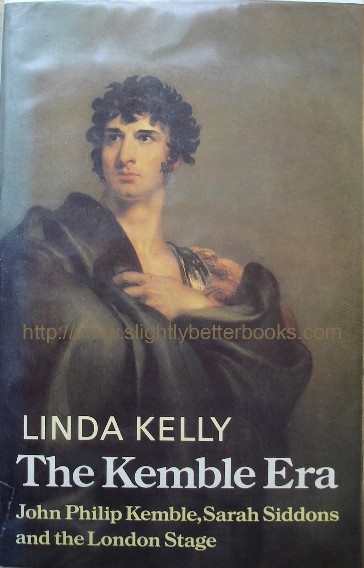
1980, The Bodley Head, hbk
Sorry, sold out, but click image or links to access prebuilt search for this title on Amazon UK
Alternative online retailers to try:
Click here to access our prebuilt search for this title on Abebooks
Click here for our prebuilt search for any edition of this book on Alibris
Or click here to access our prebuilt search for this title on Ebay



|
Contents: In 1782, Sarah Siddons had her first London triumph and found herself overnight the most famous actress in England; in 1817 her brother, John Philip Kemble, gave his farewell performance, as Coriolanus, at Covent Garden and was afterwards toasted at a banquet as 'the noblest Roman of them all'. Between these two dates, brother and sister reigned supreme on the stage, Mrs Siddons as the queen of tragedy ('nothing ever was or can be like her', Byron acknowledged), and Kemble not only as her masculine counterpart but also as the first of the great 19th-century actor-managers . Only once did their undisputed sovereignty come under challenge-for one season, by a 13-year-old boy prodigy, Master Betty.
The Kembles were children of strolling players; and though this background helped them in their chosen careers, it was by sheer talent and dignity that they attained an equal footing with the great and noble of the day. Despite a difficult marriage, Mrs Siddons maintained an irreproachable reputation: she was at the same time a mother of five children and the paramount actress of the age.
Her brother was reserved, pedantic and a formidable drinker; he didn't escape scandal, rather he rode through and over it by the sheer majesty of his personality. His frustrations at the hands of his brilliant but irresponsible partner at Drury Lane, the playwright Sheridan, provide a fascinating insight into the way in which the theatres were managed and the actors treated at the time.
Linda Kelly's biography of the siblings is the first in over 100 years (upto the time of publication in 1980) to embrace both subjects and paints a vivid picture not only of their private and professional lives, but also the world of the theatre, and the world that revolved around the theatre. Kemble's notebooks, both their letters, the newspaper items of the day, the opinions of contemporary critics, the memoirs of their friends, enemies and rivals -all provide a picture rich in gossip and detail.
Illustrations Included:
1. Mrs Siddons as Isabella, Henry Siddons as her son, in Isabella
2. The pit entrance to Drury Lane on a Siddons night
3. Kemble as Hamlet, 1783
4. Richard Brinsley Sheridan
5. Kemble and Mrs Siddons as Mr and Mrs Beverley in The Gamester
6. Mrs Siddons as Melpomene
7. Mrs Siddons as Euphrasia
8. Garrick and Mrs Pritchard in Macbeth
9. Macbeth and Lady Macbeth after the murder of Duncan
10. Kemble and Mrs Siddons in Macbeth
11. Mrs Jordan as Euphrosyne
12. Mrs Jordan as Viola
13. Thomas King as Brass in The Confederacy
14. Priscilla Hopkins (later Mrs John Philip Kemble) as Peggy in The Country Wife
15. Mrs Siddons by Gainsborough
16. Mrs Siddons as the Tragic Muse
17. Mrs Inchbald
18. Kemble as Coriolanus
19. Title page of the vocal score of Blue Beard
20. The Kembles in Henry VIII
21. Maria Siddons
22. Thomas Lawrence
23. William Siddons
24. Sally Siddons
25. Mrs Siddons in 1797
26. 'Promenade en famille': The Duke of Clarence, Mrs Jordan and their children
27. Kemble on stage in Pizarro
28. Kemble as Rolla in Pizarro
29. Michael Kelly
30. Charles Kemble
31. William Henry Ireland
32. Master Betty as Young Norval
33. John Bull in Lilliput
34. 'Theatrical Mendicants Relieved'
35. Acting Magistracies on stage during the OP riots
36. George Frederick Cooke as Richard III
37. Edmund Kean as Sir Giles Overreach
38. Kemble as Richard III |
|

1990, Hodder and Stoughton, hbk
Alternative online retailers to try:
Click here to access our prebuilt search for this title on Abebooks
Click here for our prebuilt search for any edition of this book on Alibris
Or click here to access our prebuilt search for this title on Ebay
|
- The Kindness of Strangers [top]
Written by Bernard Braden
First published in 1990 in Great Britain by Hodder & Stoughton in hardback, with dustjacket, 281pp, ISBN 0340525274
Original UK retail price: £15.00 net. Front cover shows Bernard Braden in 'A Streetcar Named Desire' at the Aldwych Theatre, London. Photograph of the author on the rear dustjacket flap was taken by Maurice Ambler
About this book/synopsis: Bernard Braden and his wife Barbara Kelly arrived in Britain from Canada in 1949, not realising that within months they would have captured the imagination and the hearts of the British public, would be written about in the British press and flattered by people they had long admired. Barbara starred in 'The Male Animal' at the New Theatre, then Bernard appeared as "Mitch" in Tennessee Williams' 'A Streetcar Named Desire', directed by Laurence Oliviers and starring Vivien Leigh. Both established the Bradens as a force to be reckoned with in London theatre.
Radio was the medium that really worked the magic for the Bradens, making their popular reputations. Britain was still in the grip of post-war rationing; and the austerity of this time meant that the Bradens were a breath of fresh air to the country.
The story contained within ends on Christmas day in 1950 at a point prior to Barbara becoming a household name on 'What's My Line?'. In the 1950s, 'What's My Line', which ran from 1951-1963, was almost obligatory viewing for British households with a TV set in the 1950s- Canadian Barbara's lively and witty personality lit up the screen providing television with a presence that helped it fight for ratings with the radio and cinema. Eamonn Andrews was panellist chairman and her fellow panellists were Jerry Desmonde, Marghanita Laski and Ted Kavanagh.
Fully illustrated throughout with black and white photographs, the book talks about how Bernard Braden came to meet Barbara Kelly and their subsequent courtship and move to Britain. It contains excerpts from scripts and conversations and is packed full of interesting events and snippets of information about the Braden's famous and celebrity contemporaries and friends, e.g. Norman Shelley, Lyn Evans, Mountbatten, John Mills, Sir Laurence Olivier during the early 1950s. The Bradens' own thoughts and feelings are of course also represented in the book.
Subsequent to the story covered in this book, Bernard Braden was a commentator at Queen Elizabeth II's Coronation and introduced the first BBC TV schools' broadcast. He was also behind the first consumer programme 'On the Braden Beat' and is the only television performer ever to have won (up to 1990 - the year this book was published) the Richard Dimbleby Award as "Factual Performer of the Year". He has also won the Variety Club Award for Light Entertainment Performer of the Year, and the Royal Television Society Award for "Artistry in Front of the Camera". These awards were all won for the same programme.
Bernard Braden died on 2nd February, 1993; Barbara Kelly died on 15th January 2007 |
|
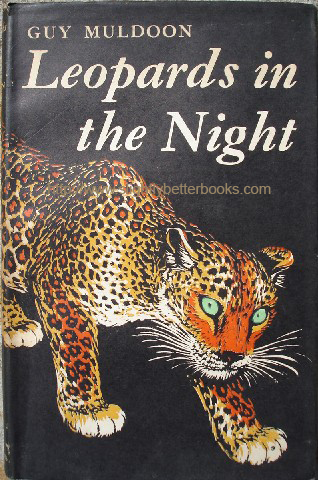
1955, Rupert Hart-Davis, hbk
Sorry, sold out, but click image or links to access prebuilt search for this title on Amazon UK
Alternative online retailers to try:
Click here to access our prebuilt search for this title on Abebooks
Click here for our prebuilt search for any edition of this book on Alibris
Or click here to access our prebuilt search for this title on Ebay |
- Leopards In The Night [top]
Written by Guy Muldoon and illustrated by Ralph Thompson, who also designed the dustjacket
First published in 1955 in Great Britain by Rupert Hart-Davis (36 Soho Square London, W1) in hardback with dustjacket, 234pp
in Great Britain by Rupert Hart-Davis (36 Soho Square London, W1) in hardback with dustjacket, 234pp
Original UK retail price: 16 shillings net
Includes map of area on page 6
About this book/synopsis: Few men can ever have known the great fauna of Africa better, loved them more and killed so many of them as Guy Muldoon. The paradox is not unfamiliar, but here the killing has not been done for sport. Mr. Muldoon was an Agricultural Officer in Northern Nyasaland, who, in the course of his duties, had to protect the lives and livelihoods of the natives in his area against the depredations of lions, leopards, buffaloes, elephants, gorillas, crocodiles and other wild beasts that ravage crops and cattle, destroying livelihoods and occasionally the humans themselves.
In order to better protect his charges, the author has had to make an indepth study of the characters and habits of all the various creatures around him and has therefore been able to include a chapter on how he tried to bring up two leopard cubs whose mother he had had to kill
Chapters:
1. The Case of the Vanishing Lions
2. Lions Hunt Also
3. A Lone Raider
4. Elephants
5.
Wanderlust in the Game Reserve
6. Close Quarters with Crocodiles
7. Hippo-hunting by Canoe
8. A Lesson in Leopard
9. A Close Call
10. Leopards in the House
11. Baboon War
12. Pigs, Wild and Tusky
13. Buffalo, the Real Hater
14. Leopards in the Night
15. The Goat that Gave the Game Away
16. Human Bait |
|
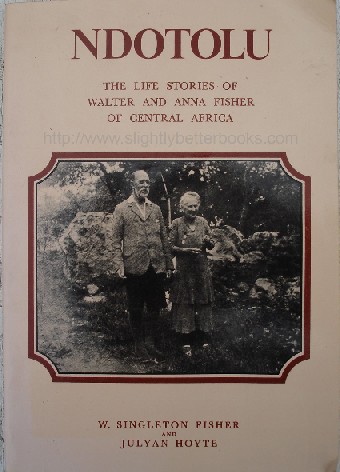
1992, Lunda-Ndembu Publications, pbk
Sorry, sold out, but click image to access prebuilt search for this book on Amazon
Alternative online retailers to try:
Click here to access our prebuilt search for this title on Abebooks
Click here to access our prebuilt search for this title on Alibris
Or click here to access our prebuilt search for this title on Ebay



|
- Ndotolu: The Life Stories of Walter and Anna Fisher of Central Africa [top]
Written by W. Singleton Fisher and Julyan Hoyte
First published in Great Britain in 1948 by Pickering and Inglis under the title 'Africa Looks Ahead', London in hardback, 212 pp Illustrated with sepia photographs and colour endpaper maps
Reprinted in 1987 in Zambia by Miss Joan Hoyte, Lunda-Ndembu Publications, as a revised edition under the new title in a print run of 3,000
Reprinted in 1992 in Zambia by Miss Joan Hoyte, Lunda-Ndembu Publications, as a revised edition under the new title in a print run of 2,000. Includes Appendix of The Family of Walter and Anna Fisher; then maps: 'The Beloved Strip in The 1930's'; and 'Northern Rhodesia, Showing Kalene Hill District'
- Other Relevant Chapters: Christianity
Contents: Formerly published in 1948 as 'Africa Looks Ahead' by Pickering & Inglis, this revised edition was reprinted into 3,000 new copies in 1987 and then again into a further 2,000 copies in 1992. Walter Fisher (born November 28th, 1865 in Greenwich) was a promising young surgeon, who along with his wife Anna Fisher (Susanna Elizabeth Darling, of New Ross, County Wexford, Ireland, June 10th, 1865-born to John Singleton Darling and his wife Mary Anne, née Johnston) gave up his life in the service of the people of Central Africa, suffering great privations, professional isolation and dying comparatively early, worn out by his years of toil. They saved countless lives who but for them would otherwise have perished because there was no-one else to help them. They restored to health people who were otherwise doomed to long suffering and helplessness; and showed fellow missionaries how to live safely in the tropics; and worked to help the natives build better homes and live amiably with their neighbours. Spiritually, they spread the Christian doctrine among the peoples they spent their time helping setting up mission stations around the Central African territories, moving onto new tribes, learning new languages and getting to know new customs; but it was moving onto the third new tribe that gave Walter and Anna much more than just another mission station because it was for nearly thirty years (from January 1906) that they worked together helping people practically and spiritually at a sanatorium at Kalene Hill in NW Zambia, the first of a long range of hills stretching from Kalene to Kalunda eighty miles away and near the source of the Zambesi. To get some idea of the legacy of Walter and Anna Fisher, it's notable that even today, Kalene Mission Hospital is still helping the local community providing many inpatient and outpatient services and a supportive Christian atmosphere
Tribes encountered: Chokwe; Lunda Tribe; Valuimbe
Chapters:
Book 1.
Foreword
1. Parentage and Youth
2. Call and Decision
3. Outward Bound
4. Starting the Long Trek
5. Except a Corn of Wheat
6. Labours Abundant
7. Rebellion and Witchcraft
8. The Helpmeet
9. True Yokefellows
10. Kavungu
11. Kazombo
12. Perils of Robbers
13. East, West, Home's Best
Book 2.
1. The Hill of God
2. Servants Unto All
3. Father and Son
4. Conversions
5. The War Years
6. Witchcraft and Witches
7. Orphans and Schools
8. Dr. and Mrs. Fisher's Influence on Others
9. At Evening Time It Shall Be Light
Appendix |
1992, Lunda-Ndembu Publications, pbk
Older Editions:
|
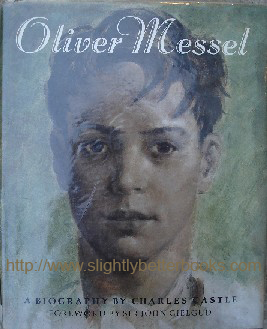
1986, Thames & Hudson, hbk
Sorry, sold out, but click image or links to access prebuilt search for this title on Amazon UK
Alternative online retailers to try:
Click here to access our prebuilt search for this title on Abebooks
Click here to access our prebuilt search for this title on Alibris
Or click here to access our prebuilt search for this title on Ebay
Click here to access our prebuilt search for this title on Biblio



|
- Oliver Messel [top]
Written by Charles Castle; Foreword by Sir John Gielgud
With 145 illustrations, 20 in colour. Jacket front is a self portrait at the age of approximately 19
First published in 1986 in Great Britain by Thames and Hudson, in hardback, 264pp, ISBN 0500234345
- Related Publications:
Note that Janet Leeper's English Ballet volume from December 1944 (reprinted subsequently) contains 3 colour plates (10, 11, and 12) of Oliver Messel's work:
(reprinted subsequently) contains 3 colour plates (10, 11, and 12) of Oliver Messel's work:
10: Backcloth for Shakespeare's A Midsummer's Night's Dream produced at the Old Vic Theatre, London, December 27th, 1937
11. A Scene from Comus, masque in one act and two scenes after Milton by Robert Helpmann, first produced by the Sadler's Wells Company at the New Theatre London, January 14th, 1942. The design shows the wood (scene 1) in which the Lady, searching for her brothers, first meets Comus, who leads her away towards his palace
12. Costume design for masque of Comus (scene 2)
About this book/synopsis: This is a biography of a remarkable man, based mainly on autobiographical notes Messel left at his death to his nephew (The Earl of Snowdon), who had a brilliant career as a designer for theatre, ballet, opera and films, spanning four decades from the early 1920s to his death in 1978. To his host of admirers, his work was the epitome of good taste, delicate fantasy and magical illusion. Although he was a remarkably assiduous and painstaking artist, he was also well placed socially to become a familiar figure in the merry party-going circles of London, the Continent and New York from the '20s to the '50s. He came from a prominent banking family, and his personal charm and striking good looks endeared him not only to society's arbiters, but also to those who patronised the arts and architecture.
After meeting with initial success and when still very young, Oliver became the world's most sought-after and highly paid scenery and costume designer with his contributions to C. B. Cochran's musical productions (e.g. Helen! and went on to experience triumph after triumph in both the West End and Broadway.
He notably created enchanting and memorable designs for: The Little Hut, Ring Round the Moon and The House of Flowers. He is also particularly well remembered for his designs for the Royal Ballet's first post-war production of The Sleeping Beauty, a production which celebrated the re-opening of The Royal Opera House in Covent Garden. His talents have not just been confined to the stage though - he produced the costumes and sets for the film Romeo and Juliet with Norma Shearer and Leslie Howard; and also for Suddenly Last Summer, which starred Elizabeth Taylor and Katharine Hepburn. He won an Oscar nomination for this.
Later years saw him take up his interest in architecture and interior decoration; as a result he was the creator of some charming and original houses in Barbados and Mustique.
The author includes personal interviews with members of Messel's family, friends and professional colleagues. The illustrations included cover all aspects of the artist's career.
Chapters:
Foreword by Sir John Gielgud; Preface
1. Family Feeling
2. The Cochran Connection
3. Thirties Revisited
4. Regal Roles
5. From Fry to Fantasy
6. Foreign Features
7. 'Marriage' to the Met
8. Islands in the Sun
9. Maddox
Sources and acknowledgements; chronologies; index |
|
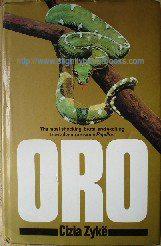
1987, Bantam, hbk
In stock, click to buy for £9.85, not including p&p
Alternative online retailers to try:
Click here to access our prebuilt search for this title on Abebooks
Click here to access our prebuilt search for this title on Alibris
Or click here to access our prebuilt search for this title on Ebay |
- Oro [top]
Written by Cizia Zyke; Translated by Stanley Hochman
First published in 1987 in Great Britain (UK 1st Edition) by Bantam Books in hardback with dustjacket, 281pp, ISBN 0593011368 . . Original UK retail price: £10.95 net; NZ - $29.95 GST Inc.; AUS $26.95
Original UK retail price: £10.95 net; NZ - $29.95 GST Inc.; AUS $26.95
Cover illustration by Chris Brown. Author photograph (on rear of book) by Dominique Aubert
Contents/outline: This is the story of one man's search for gold. Cizia Zyke is the ultimate
adventurer, always in search of a bigger and better game. Oro traces the
rise and fall of his fortunes in South America from solo prospecting on the
Osa peninsula to the search for antiquities in the Colombian jungle. Zyke
survived snakes, hostile natives, a near-fatal bout of malaria and the
terrors of the continent's notorious prisons to continue his single-minded
quest - a real-life Indiana Jones with a breath-taking tale to tell.
Hard-drinking, hard-talking and an insatiable womanizer, Zyke nevertheless
maintained his own strict code of honour in all his dealings.
|
|
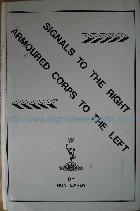
1993, Korvet Publishing and Distribution, hbk
In stock, click to buy for £4.00, not including p&p
Alternative online retailers to try:
Click here to access our prebuilt search for this title on Abebooks
Click here to access our prebuilt search for this title on Alibris
Or click here to access our prebuilt search for this title on Ebay |
- Signals to the Right; Armoured Corps to the Left [top]
Written by Ron Larby; Preface by Ashley Cunningham-Boothe.
Fay Wilshire produced the dustcover and Ron Stevens lent his skills in reproducing old photographs
First published in 1993 in Great Britain by Korvet Publishing and Distribution, 176pp, ISBN 0951775022
About this book/synopsis: This book is about the author's experiences as a National Serviceman in the Royal Corps of Signals and during the Korean War (1950-1953). The author was born in 1932 in SW London within the atmosphere of the Guards Brigade barracks at Chelsea and of Birdcage walk and Pirbright, where his father was a regular soldier with the Scots Guards. As an eight year old, he was evacuated in 1940 to Cornwall, spending much of the war there before returning to live in NW London. In 1950, he was called up for National Service and joined the Royal Signals ; eventually serving in the Far East and then in the Korea war. He had toyed with the notion of signing on as a regular soldier, but decided that after his experiences during the Korean war, it would be an anti-climax. Virtually all his working life has been spent with Lucas industries at their CAV Action Works where, until forced into early-retirement by the economic recession, he had been employed for many years in the Electrical Laboratory, building and testing prototype generating systems for military and commercial vehicles.
It was his membership of the Herts and District Branch of the British Korean Veterans association which rekindled the comradeship he had last known in the Army and in 'The Forgotten War' of Korea.
Chapters:
Introduction
1. Signals to the right...armoured corps to the left
2. The four horsemen ride
3. Wah, Two, Three, Wah!
4. You're a soldier first, a tradesman second
5. Morse Happy
6. O.W.L. BIII Fully Qualified
7. The Trooper is on the tide
8. East of Suez
9. The Happy Time
10. Across the River and Into the Hills
11. Not so Quiet on the West Central Front
12. The Winter of Our Discomfort
13. The Sharp End
14. A Time Out of War
15. The Imjin Line
16. Return from the Morning Calm
17. And after, once again, moving on |
|
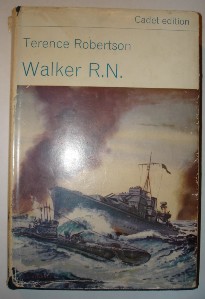
Sorry, out of stock, click image to access prebuilt Amazon search!
Alternative online retailers to try:
Click here for our prebuilt search for this book on Abebooks
Click here for our prebuilt search for any edition of this book on Alibris
Or click here to access our prebuilt search for this title on Ebay |
- Walker R. N. [top]
Written by Terence Robertson
First published in 1965 by Evans Brothers Limited, London, 192 pages, hardcover, with dustjacket
by Evans Brothers Limited, London, 192 pages, hardcover, with dustjacket
About Terence Robertson:
Terence Robertson was born in London at the close of WW1, and volunteered to fight in WW2 as a Naval Reserve Officer as early as September 1938-the time of Munich. He was called up in July 1939 and his subsequent service included 18 months of convoy work in the Atlantic.
After the war, he returned to his profession, journalism, and went to South Africa where he worked in Durban and Johannesburg. In 1949, Terence Robertson came back to London to take up an executive appointment with a national Sunday newspaper.
He travelled widely in the US (he claimed to have outdone many an American by sailing from the Canadian border to New Orleans, via the Great Lakes, the Illinois River and the Mississippi), Mexico, Venezuela, Brazil and the Argentine.
He has also written:
The Golden Horseshoe
The Ship with Two Captains
Channel Dash
Contents: [From the dustjacket flap:]
'According to an admiralty statement, the Battle of the Atlantic, which raged for 5.5 years, was 'the most protracted and bitterly fought campaign in which the British Empire and her Allies have ever been engaged'. That this battle was triumphantly won was the direct result of the offensive tactics of the Navy's 'little ships', inspired by the brilliant exploits of one man who, the Admiralty stated, 'did more to free the Altantic of the U-Boat menace than any other single officer'. Here, then, is this man's story-the life and death of Captain Frederic John Walker, R. N., Companion of the Order of the Bath, and holder of the D.S.O. and three Bars. Working with the complete co-operation of Captain Walker's family and with full access to private papers and diaries, the author traces the career of this indomitable sailor from his early years as a midshipman in H.M.S Ajax to his last voyage in the sloop Starling.
This is a magnificent and inspiring record of devotion to duty and unfaltering courage.
Terence Robertson tells in vivid, authentic detail the unrelenting struggle waged by Captain Walker and the men under his command to beat the menace of the German U-Boat |
1958, hardback
|
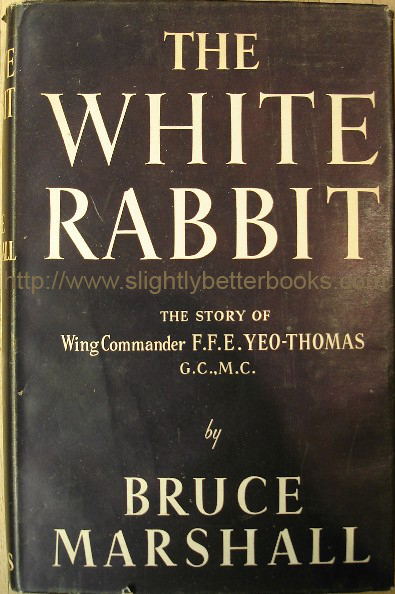
1956, Evans Brothers, hbk
Sorry, sold out, but click image to access prebuilt search for this title on Amazon UK
Alternative online retailers to try:
Click here to access our prebuilt search for this title on Abebooks
Click here for our prebuilt search for any edition of this book on Alibris
Or click here to access our prebuilt search for this title on Ebay |
About the book/synopsis: The White Rabbit was one of the code names arranged to indicate the movements of Wing Commander Yeo-Thomas during his perilous missions to occupied France. When the plain language broadcasts of the BBC to Europe stated that the White Rabbit had gone back to his hutch, it meant that not only the French Resistance, but also the Gestapo knew that Tommy had returned safely to Britain. Yeo-Thomas only found this out himself when the Germans captured him. In fact, he made such good use of it that everyone who reads his amazing story will agree that it could not have been published under any other title. When Yeo-Thomas received his last briefing from the Prime Minister, Mr. Churchill said: 'You have chosen an unorthodox way of doing things and you have short-circuited official channels; it might mean trouble for you, but I shall see that no such thing happens....I am going to increase substantially the number of aircraft doing parachuting operations to the Resistance, and greater supplies and more armament are going to be sent.'
Not long after the personal triumph of hearing Mr. Churchill use these words Yeo-Thomas ws in the hands of the Gestapo. Did the war produce great literature? Most likely the answer is yes - it certainly produced some amazing tales of individual adventure and courage - and there can surely be few to equal that of Yeo-Thomas, who started the war and ended the war as manager of the famous Molyneux dress salon in Paris. How Tommy spent the 'phoney' war in the ranks of the Royal Air Force; how he was commissioned after the fall of France and how he became a specialist in organizing Resistance - these things are all told within the pages of this famous work. The story of how he was captured and treated by the Gestapo, and ended in being one of the few British survivors of Buchenwald, would be distressing were it not so triumphantly fortified by this man's enduring courage. His qualities were recognized by His Late Majesty King George VI in the award of the George Cross and by the French Government in the award of the Legion of Honour.
About the Author: Bruce Marshall was a natural choice to write about Yeo-Thomas because they were close friends for a long time - the author also lived in France for and knew the subject for many years. He worked in Special Branch of the Service during the war and is therefore very familiar with the background both in London and France of The White Rabbit's exploits.
The author was born in Edinburgh and was educated at Edinburgh Academy, Glenalmond, St. Andrews and Edinburgh University. In WW1, he served in the Royal Irish Fusiliers only to be wounded, also losing a leg. Post war, he became a Chartered Accountant in 1926 working in France until June, 1940. After this time, he served with the Intelligence Services, finally becoming a Lieutenant-Colonel on the Allied Commission for Austria. |
|
|
Biographies & Memoirs on Ebay:
|
[top] |














